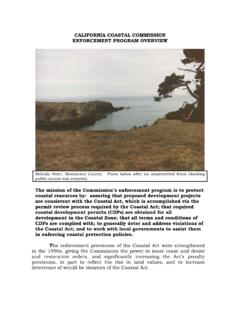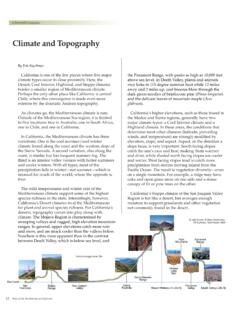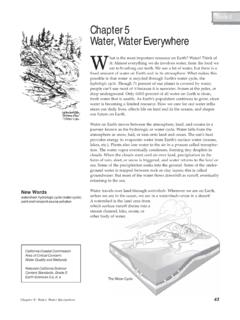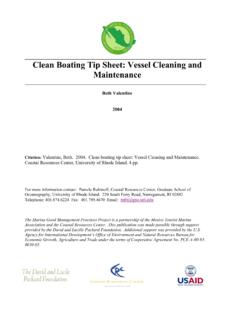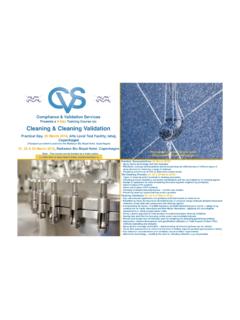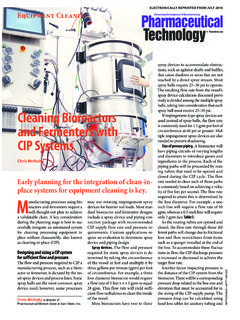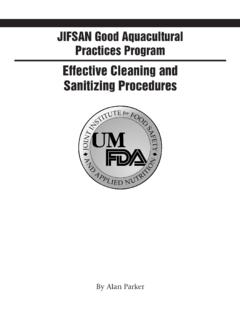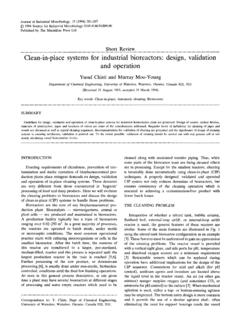Transcription of Boat Hull Cleaning and Hull Paint, Water Quality …
1 Water Quality Factsheet Boat hull Cleaning and hull paint Introduction Pollutants generated from boat hull maintenance and Cleaning may impair Water Quality and threaten the health of aquatic systems. Chemicals used in top side and under Water Cleaning can also degrade Water Quality . Water Quality impacts can be avoided or lessened by using non-toxic Cleaning products, minimization or elimination of toxic Cleaning agents, and implementation of practices that prevent or reduce opportunities for toxic products to contact surface Water . California s Non Point Source Pollution Control Program (CNPSP) recommends management measures to avoid or minimize impacts to Water Quality and habitat from boating and marina activities.
2 These measures were developed for facilities with 10 or more boats, but may also be appropriate for small facilities. This factsheet focuses on BMPs related to in- Water boat hull Cleaning and hull paints. It does not address boat maintenance above the Water line, minor maintenance conducted in the on-shore areas of marinas, or boat maintenance in commercial boat yards. At the time the CNPSP was approved there were no management measures related to boat hull maintenance, this is an area of expanding regulation and development of hull paint alternatives. Boat hull paints and threats to Water Quality Boats that are kept in the Water have always required maintenance effort to remove species such as barnacles, oysters, mussels, shipworms, or algae that become strongly attached to boat hulls.
3 These so-called fouling organisms cause drag that can significantly slow the vessel, alter maneuverability, and damage the hull . Copper has been a standard ingredient in hull paints for many decades, but it has only been in the last ten years that Water Quality sampling has shown that the paint , in some cases, can cause exceedences of Water Quality standards. Antifouling coatings work by slow release of a toxic chemical (biocide) from the hull coating, or by presenting a hard or slippery surface that minimizes attachment by organisms. Some antifouling paints are made to slowly release particles over time (ablative coating), continually exposing fresh biocides to fouling organisms.
4 Copper-based antifouling hull paints are currently the most commonly used antifouling coating. Copper discourages fouling organisms, but also slowly leaches into the Water column and can be released from the hull as particles that fall to the sediment. In some southern California waters high densities of boats with copper bottom paint and restricted circulation have exceeded Water Quality standards and been included on the state s list of impaired waters1. Since no antifouling paints are completely effective, in- Water hull Cleaning is a standard maintenance practice for boats that are kept in the Water . In the case of soft or ablative copper paints, this maintenance also releases some paint to the Water column.
5 Ideally this should be paint that already has release copper at a slow rate that does not cause exceedences of Water Quality standards. If hull Cleaning is too vigorous, or if the paint is not properly adhering to the 1 Clean Water Act Section 303(d) requires state s to list waters that have ongoing failure of Water Quality standards and develop a schedule for restoring Water Quality by various methods possibly including a total maximum daily load (TMDL) limit on discharges that can create restrictions on land use. 4/20/2011 Page 1 of 4 hull , fresh paint with active copper or paint flakes can be released to the Water .
6 These conditions significantly increase the likelihood that the Water will fail Water Quality standards. Copper Free hull Paints New alternatives to copper based antifouling hull paints have been developed in response to Water Quality concerns, although not all alternative coatings have been registered by the California Department of Pesticide Regulation. Non-toxic paints will not need to be registered. The purpose, frequency of use, and storage location of a boat will determine what type of hull coating is appropriate. Alternative hull coatings can be classified into two categories: biocide and non-biocide hull coatings.
7 Biocide coatings are designed to slowly release toxic substances such as copper, zinc pyrithione, fluorine, chlorine and various organic biocides, including a new organic biocide called Econea. Non-biocide coatings can be further classified as soft or hard. Soft non-biocides may contain silicon or fluoropolymers that result in a slick surface making it difficult for organisms to attach. Hard non-biocides may be ceramic or epoxy and are generally used on racing boats and boats stored out of Water . Non-biocide products generally last longer than copper-based and zinc oxide paints. The effectiveness in terms of cost, application, efficiency, longevity, maintenance, and antifouling properties of alternative copper-free coatings were compared in an EPA-sponsored study conducted by the Port of San Diego and the Institute for Research and Technical Assistance (IRTA)2.
8 Application and Cleaning methods were also evaluated to consider the cost of alternative paint use compared to copper-based paint . The cost to convert a copper-based paint to an alternative coating is based on multiple factors. Conversion can be expensive since alternative coatings often require stripping of the copper paint and because the cost for spray application is higher than painting with a roller (in part due to the facilities needed to ensure that sprayed paint is not released to the environment). Long term cost variability includes differences in hull Cleaning frequency, and longevity of the paint before reapplication, which could be longer for non-biocide paints when compared to copper paint .
9 The Cleaning schedule and appropriate tools for Cleaning alternative paints may be different than for copper-based paints3. The study recommends that boats with alternative coatings could be inspected regularly and cleaned when a visual inspection determines the presence of fouling organisms, and Cleaning of biocide coatings could be concentrated in areas of dense growth. A slime layer may not require immediate Cleaning . Soft biocides are hand cleaned to prevent damage to the coating if extra pressure is used to remove fouling organisms. The IRTA study concluded that for recreational boaters, non-biocide coatings have many advantages over copper-based paints over the long run.
10 Alternative paints currently cost more to 2 Institute for Research and Technical Assistance (IRTA), Environmental Protection Agency Project NP00946501-4; Safer Alternatives to Copper Antifouling Paints for Marine Vessels Final Report; January 2011 (Los Angeles: The Alternative, IRTA Newsletter, Winter 2011). 3 Unified Port of San Diego and Institute for Research and Technical Assistance, US Environmental Protection Agency Project, NP00946501-4: Safer Alternatives to Copper Antifouling Paints for Marine Vessels Final Report (San Diego: Port of San Diego, January, 2011) 4/20/2011 Page 2 of 4 purchase and initially apply than copper paints; however, because the non-biocide coatings last longer and need less frequent Cleaning , these may be more cost effective over time.
